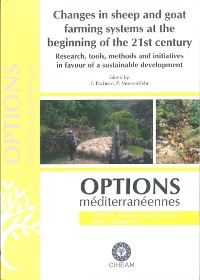| Article précédent | p. 215-219 | Article suivant |
The project IOSTO as a contribution to the enhancement of sheep breeding in mountain areas of Sardinia
The authors describe several phases of a project aiming at the production, evaluation and enhancement of a new meat foodstuff, the suckling lamb obtained by crossing Ovis aries with Ovis g musimon. This crossbred was mentioned since the first century A.C., and nowadays its birth is still possible in natural environment, where sheep farms are close to the mouflon habitat. This foodstuff could be proposed as a gastronomic attraction in the naturalistic mountain areas of Sardinia. The research has a dual purpose: (i) to stimulate the regional sheep farming, which is undergoing an economic crisis, despite its great productive potential; and (ii) to establish a stronger link between animal husbandry and tourism, the two most important sections of the Sardinian economy. The project started with the registration of a trademark, IOSTO. Later, it was followed by the birth of the crossbred lambs, the analysis of reproductive and productive parameters, the sensorial and chemical examination of meat, the training of traceability methods and finally the marketing analysis. The letter S, included in the trademark name, has a symbolic meaning, because the project brings together several partners such as University (conception and implementation), sheep breeders (production), restaurant tenants (marketing) and public bodies (sponsoring and assistance).
Les auteurs décrivent les diverses phases d'un projet ayant pour objectif la production, l'évaluation et la valorisation d'un nouveau produit carné ovin représenté par l'agneau de lait obtenu par l'accouplement entre Ovis aries et Ovis g musimon. Ce croisement, dont l'existence a été rapportée dès le premier siècle après JC, se réalise encore naturellement dans les aires où l'élevage ovin est proche de l'habitat du mouflon. Ce produit peut constituer un élément d'attraction gastronomique dans les aires montagneuses naturelles de la Sardaigne où vit encore le mouflon à l'état sauvage. Cette recherche a un double objectif : (i) stimuler le secteur ovin régional qui, malgré ses grandes potentialités productives, subit une crise ; et (ii) instaurer un lien plus solide entre les deux importants secteurs économiques de l'île, à savoir, l'élevage et le tourisme. Le projet a démarré avec l'enregistrement d'une marque, IOSTO, suivi par la production des animaux, avec l'analyse des différents paramètres reproductifs et productifs. Puis une évaluation chimique et sensorielle des viandes a été réalisée ainsi q'une mise au point des méthodes pour la traçabilité du produit. Le programme s'est poursuivi par l'étude de marché. La même lettre S de la marque a une signification symbolique étant donné que le projet regroupe plusieurs partenaires comme l'Université (conception et réalisation), les éleveurs (production), les restaurateurs (commercialisation) et les administrations publiques (collaboration et sponsorisation).
- [ Afficher ]
- [ Télécharger ]
- [ Exporter la citation ]
Vous pouvez télécharger la citation au format :
- [ Imprimer ]
-
Mots-clés
BREBIS, MOUFLON, PRODUIT NOUVEAU, REGION D'ALTITUDE, SARDAIGNE, VIANDE D'AGNEAUCiter cet article
Vacca G.M., Carcangiu V., Dettori M.L., Pazzola M., Rocchigiani A.M., Luridiana S., Bini P.P. The project IOSTO as a contribution to the enhancement of sheep breeding in mountain areas of Sardinia. In : Pacheco F. (ed.), Morand-Fehr P. (ed.). Changes in sheep and goat farming systems at the beginning of the 21st century : research, tools, methods and initiatives in favour of a sustainable development . Zaragoza : CIHEAM / DRAP-Norte / FAO, 2009. p. 215-219. (Options Méditerranéennes : Série A. Séminaires Méditerranéens; n. 91). Proceedings of the Seminar of the Subnetwork on Production Systems of the FAO-CIHEAM Network for Research and Development in Sheep and Goats, 2007/11/15-17, Ponte de Lima (Portugal). http://om.ciheam.org/om/pdf/a91/00801148.pdf



